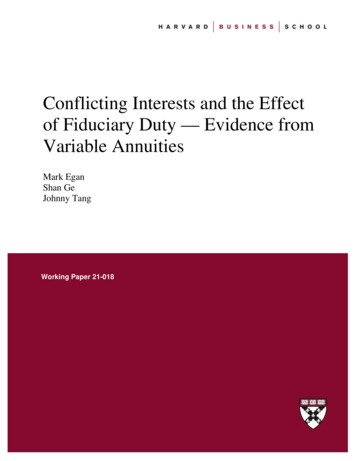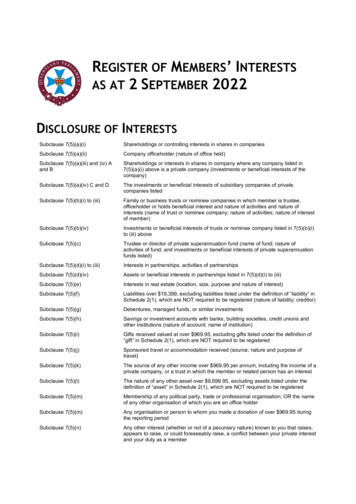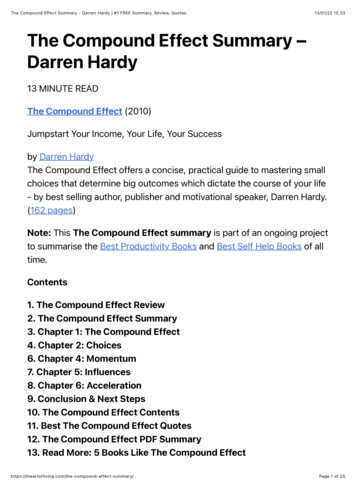
Transcription
Conflicting Interests and the Effectof Fiduciary Duty — Evidence fromVariable AnnuitiesMark EganShan GeJohnny TangWorking Paper 21-018
Conflicting Interests and theEffect of Fiduciary Duty —Evidence from VariableAnnuitiesMark EganHarvard Business SchoolShan GeNew York UniversityJohnny TangHarvard UniversityWorking Paper 21-018Copyright 2020 by Mark Egan, Shan Ge, and Johnny Tang.Working papers are in draft form. This working paper is distributed for purposes of comment and discussion only. It maynot be reproduced without permission of the copyright holder. Copies of working papers are available from the author.Funding for this research was provided in part by Harvard Business School.
Conflicting Interests and the Effect of Fiduciary Duty —Evidence from Variable AnnuitiesMark Egan, Shan Ge, and Johnny Tang AbstractWe examine the drivers of variable annuity sales and the impact of a proposed regulatorychange. Variable annuities are popular retirement products with over 2 trillion in assets in theUnited States. Insurers typically pay brokers a commission for selling variable annuities thatranges from 0% to over 10% of investors’ premium payments. Brokers earn higher commissionsfor selling inferior annuities, in terms of higher expenses and more ex-post complaints. Ourresults indicate that variable annuity sales are roughly five times more sensitive to brokers’financial interests than investors’. To help limit conflicts of interest, the Department of Laborproposed a rule in 2016 that would hold brokers to a fiduciary standard when dealing withretirement accounts. We find that after the proposed fiduciary rule, the sales of high-expensevariable annuities fell by 52% as sales became more sensitive to expenses and insurers increasedthe relative availability of low-expense products. Based on our structural model estimates,investor welfare improved as a result of the fiduciary rule under conservative assumptions.JEL Codes: G24, G28, D14, D18, G22Keywords: Variable Annuity, Brokers, Conflicts of Interest, Fiduciary Duty Mark Egan: Harvard Business School and NBER, megan@hbs.edu. Shan Ge: Stern School of Business, New YorkUniversity, sge@stern.nyu.edu. Johnny Tang: Harvard University, jtang01@g.harvard.edu. We are grateful for comments and suggestions by Ralph Koijen, Andrei Shleifer, Richard Rosen, Annette Vissing-Jorgensen, Motohiro Yogo, andthe seminar participants at Ohio State University, New York University, and the WFA Early Career Women in FinanceConference. Shan Ge acknowledges financial support of the Center for Global Economy and Business at NYU.
1IntroductionVariable annuities are one of the most popular retirement products in the United States. As of 2018,American households held over 2.2 trillion of assets in variable annuity accounts. Despite theirprevalence, variable annuities have been criticized for having high expenses and are the most commonly cited financial product in brokerage customer complaints (Egan et al. (2019)).1 Part of thecriticism pertains to the distribution of variable annuities.2 Variable annuities are sold through brokers who are typically paid a commission by the insurance company for selling its products. Thereis substantial heterogeneity in commissions, ranging from 0 to over 10% of the investment, whichprovides strong incentives for brokers to sell certain variable annuities over others and potentiallycreates conflicts of interest between brokers and their clients. Concerns over conflicts of interestin these types of retirement products prompted the United States Department of Labor (DOL) topropose a rule imposing fiduciary duty on brokers, which was announced in 2015 and issued in2016. The rule would obligate brokers to act in their clients’ best interests when selling retirementproducts such as variable annuities. Although the rule was ultimately vacated in 2018, the annuityindustry underwent many changes to comply with the rule starting in around 2016.This paper has two goals. First, we study the drivers of variable annuity sales and examinehow sales respond to broker and investor incentives. We find that while investor incentives matter,broker incentives play a more important role in determining sales. Moreover, brokers’ incentivesconflict with their clients’: brokers earn higher commissions for selling inferior annuities that havehigher expenses, as well as fewer and worse-performing investment options. Second, we examinehow the proposed fiduciary rule, which was intended to limit conflicts of interest, impacted thevariable annuity market in the United States. We examine how the composition of variable annuities both offered by insurers and sold by brokers changed in response to the DOL rule. We findthat the rule helped reduce conflicts of interest. In response to the rule, annuity sales flows becametwice as sensitive to expenses as before the rule and the sales of annuities with expenses in the topquartile fell by 52%. Moreover, the relative availability of high-expense products declined following the rule. To assess the overall implications of the proposed rule change, we build and estimatea structural model of variable annuity demand that allows us to quantify how the DOL fiduciaryrule impacted investor surplus. On one hand, investors should benefit from the rule change, as itreduces conflicts of interest. However, on the other hand, investors may be hurt by the rule changeif it reduces the supply of financial advice.We construct a panel dataset on variable annuity distribution using data on sales and productcharacteristics from Morningstar and regulatory filings. A key novel feature of our dataset is thatwe observe the commission rate that insurers pay to brokers for selling variable annuities. This variable allows us to separate the effect of brokers’ preferences from those of investors. ConditionalExamples: d 7/30/2020]2See e.g. FINRA rDocument/p125846.pdf [accessed7/30/2020])11
on the risks and return characteristics of a variable annuity, investors should be indifferent towardsthe associated brokerage commissions. In addition to commissions, we also observe detailed characteristics of the variable annuity products (i.e. expense ratios, investment options, benefits/riders,etc.). We match commission rates and product characteristics with quarterly product sales data.Our analysis consists of four parts. First, we study what factors drive the sales of variableannuities by analyzing how sales are related to product expense ratios, brokerage commissions,and other characteristics of the products. We find a strong negative relationship between expenseratios and sales, consistent with the notion that investors dislike high-expense products. We alsofind that brokerage commissions play a critical role in driving investment flows. Our estimatessuggest that a one standard deviation increase in brokerage commissions is associated with a 17%increase in variable annuity sales. Our baseline estimates suggest that variable annuity sales arefive times more sensitive to broker incentives than to investor incentives. These results are robustto accounting for a wide range of product characteristics including investment options and returns,availability of benefits and riders, and the insurance companies underwriting the products. We alsoexploit variation within the same product across share classes, where an insurer offers the samevariable annuity with different expense ratios and commission rates, which helps mitigate concernsabout omitted variables. We find similar patterns across share classes of the same variable annuity.Second, we present evidence of conflicts of interest in the variable annuity market. We start byexamining the types of variable annuities that brokers are incentivized to sell. We document thatthere is substantial heterogeneity in brokerage commissions. Commissions range from 0% to over10% of the principal invested and the standard deviation is 2.3%. The level and heterogeneity incommissions could create conflicts of interest if they incentivize brokers to sell products that are notdesirable for investors. Indeed, consistent with commissions creating conflicts of interest, we findthat, on average, brokers are incentivized to sell higher-expense products and products with worseinvestment options, as measured by the variety and performance of the investment options. A onepercentage point increase in expense ratios is associated with a 1.8 percentage point increase inbrokerage commissions. Collectively, our results suggest that these high-powered broker incentivesdistort investment decisions for investors.Furthermore, consistent with the idea that brokers are incentivized to sell inferior products,we find that products with high expenses—which tend to have high commissions—are associatedwith a greater number of investor complaints and higher rates of broker misconduct. To measureinvestor complaints, we utilize data from the Financial Industry Authority’s (FINRA) BrokerCheckwebsite (see Egan et al. (2019) for a further description of the data). We observe the universe ofinvestor complaints, including those pertaining to variable annuities.3 Our findings suggest thatex-post, higher-expense variable annuities are worse for investors as indicated by more frequent investor complaints against brokerage firms that sell these products. This finding also helps rule outalternative explanations that higher-expense variable annuities have unobservable (to the econo3By rule (FINRA 4530) brokerage firms are required to report all written investor complaints which includes letters,email, text messages, tweets, etc. within 30 days.2
metrician) characteristics that make them more desirable for investors, which would potentiallyexplain why insurers pay higher commission rates on these products. We also find that brokeragefirms that sell higher-expense products have higher rates of customer complaints and regulatoryoffenses as measured as per Egan et al. (2019). These results on complaints and misconduct,together with the positive relationship between broker commissions and expense ratios, suggestthat brokers are incentivized to sell products that are less desirable for investors, consistent withconflicts of interest in the market.In the third part of our analysis, we study the effect of the proposed DOL fiduciary rule. Theproposed fiduciary rule was intended to reduce conflicts of interest in retirement-related investment products such as variable annuities. In 2015, then-President Obama announced the fiduciaryrule, which was issued by the DOL in 2016 and set to be enforced starting in early 2017. Whileenforcement of the rule was delayed in 2017 and the rule was ultimately vacated in 2018, surveyevidence indicates that brokers and insurers started complying with the fiduciary rule during thisproposal and implementation period. Our results suggest that the total variable annuity sales fellby roughly 19% year-over-year after the regulation was issued by the DOL in 2016. The drop invariable annuity sales was primarily driven by a decline in high-expense variable annuity sales;sales of low-expense variable annuities remained constant over this period. The results suggestthat, in response to the proposal of the rule, brokers began complying with the rule by placinggreater weight on investor interests. We also find that insurers responded to the rule by increasing the relative availability of low-expense products available for sale. Our findings are consistentwith anecdotal evidence from annual reports of brokerage firms and insurers, where they reportedchanging their business practices in anticipation of the rule. These results imply that the regulatorychange improved the distribution of products available to investors along the extensive margin, interms of the annuities available for sale, as well as the intensive margin, in terms of the actualannuities sold by brokers. While the sales of variable annuities fell following the proposed rulechange, we do not find any evidence that investors with less wealth were disproportionately servedless by brokers following the DOL rule, as argued by the brokerage industry against the fiduciaryrule.4Lastly, we develop and estimate a structural model of variable annuity distribution to evaluatethe normative implications of the proposed DOL fiduciary rule. An advantage in our setting isthat we directly observe the alternative equilibrium we are interested in from the data. Thus, theobjective of the model is to help quantify the observed effects of the rule change rather than to solvefor a new equilibrium. In the model, investors access the annuity market through brokers such thatdemand for variable annuities is jointly determined by the preferences of investors and brokerssimilar to the framework in Robles-Garcia (2019). We use the model to recover the preferences ofinvestors and evaluate how the proposed rule impacted investor returns. On one hand, investorsshould benefit from the fiduciary rule because it reduces conflicts of interest. On the other 17.pdf[accessed 7/30/2020]43
some investors may be hurt by the rule if it raises the cost of providing financial advice, suchthat some investors are no longer serviced by brokers. We find that the proposed rule changeincreased the risk-adjusted returns of investors by up to 92 basis points (bps) per annum. Evenafter accounting for the fact that some investors may have been forced to leave the annuity marketas a result of the rule, under conservative assumptions investor welfare still improved on net. Whilesome investors were forced out of the market as a result of the proposed rule, our estimates suggestthat the DOL rule increased investor surplus, on average, as long as the risk-adjusted returns ofthose investors who were forced out of the market did not fall by more than 17 percentage pointsper annum.Our paper contributes to the literature on the role of brokers and intermediaries in householdinvestment decisions. Consistent with this prior literature (e.g. Bergstresser et al. (2008); Chalmersand Reuter (2012); Christoffersen et al. (2013); Anagol et al. (2017); Guiso et al. (2018); Egan(2019); Robles-Garcia (2019)), we find evidence suggesting that brokers are incentivized to sellhigh-expense products as high-expense products carry higher commissions on average. We contribute to this literature by providing new evidence of similar conflicts of interest in a large ( 2.2trillion) and important market, where information asymmetries between market participants, brokers and investors, loom large. The conflicts of interest in terms of the mean and standard deviationof brokerage commissions in the variable annuity market are substantially larger than those thathave been studied in other settings. For example, whereas the median brokerage commission associated with mutual funds and retail bonds is roughly 2% (Christoffersen et al. (2013); Egan(2019)), the median commission in the variable annuities market is almost 7%.5 One concernis that these conflicts of interest not only decrease investor returns, but that, perhaps more importantly, they also undermine trust in financial markets, which is critical to a well-functioningfinancial system (Guiso et al. (2008); Gennaioli et al. (2015); Gurun et al. (2018)).Our paper also contributes more generally to the literature on household investments. We findthat there is substantial heterogeneity in annuity expenses, ranging from 0.25% to 4.20% per annum. Such price dispersion has been documented in other financial products, such as mutual funds(Christoffersen and Musto (2002); Hortaçsu and Syverson (2004); Choi et al. (2010)), mortgages(Woodward and Hall (2012); Agarwal et al. (2017); Bhutta et al. (2020)), life insurance (Brownand Goolsbee (2002); Ge (2020)), and other retirement savings products (Duarte and Hastings(2012)). Price dispersion highlights the role of household sophistication in financial markets whichprovides insight into why brokers play a critical role in household investment decisions (Gennaioliet al. (2015); Foerster et al. (2017)) and why financial service providers often compete on dimensions other than price such as advertising and brokerage commissions (Gurun et al. (2016);Hastings et al. (2017); Roussanov et al. (2018)).65Our work also relates to the growing literature on financial misconduct in the financial advice industry including:Qureshi and Sokobin (2015); Egan et al. (2017); Dimmock et al. (2018); Charoenwong et al. (2019); Egan et al. (2019);Gurun et al. (2019)6A growing literature documents that financial services providers use strategic obfuscation, which may contribute tohousehold’s lack of financial sophistication (Carlin (2009); Carlin and Manso (2011); Célérier and Vallée (2017))4
Our paper also contributes to the ongoing policy debate and the literature on regulating consumer financial products (Campbell (2006); Agarwal et al. (2009); Campbell et al. (2010, 2011);Inderst and Ottaviani (2012a,b)). Specifically, we contribute new insight to this literature by evaluating the effects of an important regulatory tool, i.e. imposing a fiduciary duty on brokers. TheDOL proposal provides a unique opportunity to study the effect of such a policy attempt, which canshed light on the effectiveness of subsequent and future policy efforts such as fiduciary standardsthat have been proposed since 2018 by various states including New Jersey, Nevada, and Maryland,and on Regulation Best Interest, which was adopted by the Securities and Exchange Commission inSeptember of 2019. Our empirical analyses document that the fiduciary rule was effective in steering investment into lower-expense products, and the results from our structural model indicatethat investors benefited on average from the proposed rule. These findings relate to other workon fiduciary duty. Egan (2019) develops a broker-intermediated search model and finds that holding brokers to a fiduciary standard could increase investor risk-adjusted returns by up to 95-120basis points (bps). Our paper also builds on the work by Bhattacharya et al. (2020) which studies how cross-state variation in common law fiduciary duty impacts sales of variable and indexedannuities. The authors find that fiduciary duty increases risk-adjusted returns of annuity investorswithout decreasing sales. In contrast to Bhattacharya et al. (2020), we find that following theDOL’s highly publicized fiduciary rule that applied to all states, sales of variable annuity productsdeclined sharply, with the decline concentrated in products with high expense ratios. Bhattacharyaet al. (2020) highlight how holding a broker to a fiduciary standard could increase the fixed costsof providing advice, which will reduce the supply of financial advice; however, they do not findstrong evidence of the fixed cost channel in their state difference-in-differences setting. Also distinct from Bhattacharya et al. (2020), we document how brokerage commissions drive annuitysales and distort the investment decisions of households due to conflicts of interest.Our paper also contributes to the literature on annuities. One strand of the literature tries tounderstand forces that affect annuity demand. For example, Finkelstein and Poterba (2004) findevidence of adverse selection in the UK market. Brown and Poterba (2006) find that high-incomeand high-net-worth households are more likely to own variable annuities using survey data. Koijenand Yogo (2018) develop and estimate an equilibrium model of the variable annuity market toquantify the underlying frictions in the market. The authors estimate a Berry et al. (1995)-typemodel to estimate investor demand for variable annuities and find that sales are sensitive to products’ minimum return guarantee options and associated fees. Building on their framework, weprovide new insights by highlighting that broker commission rates are a first-order factor in determining variable annuity sales. Our paper also relates to the growing literature on the regulatoryimplications surrounding insurers and their liabilities in the US (Koijen and Yogo (2016); Drexleret al. (2017); Foley-Fisher et al. (2018); Sen (2019)).The paper proceeds as follows. Section 2 offers the institutional background of variable annuityproducts and the marketplace, as well as the DOL fiduciary rule. Section 3 describes the data.Section 4 analyzes what factors drive variable annuity sales, with our focus on product expense5
ratios and commission rates. Section 5 documents evidence of conflicts of interest in the variableannuity market. Section 6 studies the effects of the DOL fiduciary rule. Section 7 develops andestimates a structural model of variable annuity distribution. Section 8 concludes.2Institutional Details: Variable AnnuitiesIn this section, we describe the institutional setting of the variable annuity market in the US. Section2.1 provides an overview of what a variable annuity is, as well as the marketplace and distributionchannels of variable annuity products in the US. Section 2.2 describes the context and detailssurrounding the proposal of the DOL fiduciary rule.2.1What are Variable Annuities?Variable annuities are a common type of retirement savings products offered by life insurancecompanies and purchased by individual retail investors. Variable annuity products, like other typesof annuities, consist of two phases. First, in the accumulation phase, the investor makes premiumpayments to the insurance company into her variable annuity account after expenses are deducted.Later, in the distribution phase, the investor receives payments from the insurance company at fixedintervals until her death or for a specified period or a lump-sum payout.7Product Structure Variable annuities offer features similar to mutual funds and traditional fixedannuities. In the accumulation phase, variable annuity investors allocate the assets in their accountsamong a set of investment options known as subaccounts. Each subaccount usually holds sharesin a mutual fund or a fund of funds. Variable annuity products often offer multiple subaccountsfor the investor to choose from, including a combination of government/corporate bond and equityfunds spanning different industries with different investment objectives. Income and capital gainsfrom investments within the annuity account are tax-deferred.In the distribution phase, variable annuities provide investors with menus of different payoutplans. These options include life annuities with or without a refund at the annuitant’s death, andwith or without a guaranteed payout period. Instead of life annuities, the investor can also choosepayouts for a specified period or a lump-sum payout. The payout can be a fixed periodic amountor a varying amount based on the performance of the subaccounts the investor selects.Variable annuities can also offer different benefit options or riders for additional fees. Theseoptions include those that guarantee a minimum return on the assets (often referred to as a roll-upor step-up rate), while preserving the upside of the returns generated by the subaccounts selected7There are primarily two other types of annuity products: fixed annuities and fixed indexed annuities. Fixed annuitiesgrow at a predetermined fixed rate in the accumulation period and pay a pre-determined fixed rate in the distributionphase. Fixed index annuities grow based on the performance of one or more benchmark indices, such as the S&P 500and some pre-determined minimum rate. The payout in the distribution phase is determined by a combination of theperformance of the index and the minimum rate.6
by the investor.8 These options all offer minimum returns on the assets but differ in their structuresduring the distribution period.Expenses Variable annuity investors pay certain product- and subaccount-level expenses, whichare assessed as percentages of the investors’ account value. For brevity, we often refer to theseexpense ratios as expenses. There are two main types of product-level expenses. First, there isthe mortality expense (M&E), associated with the death benefits in variable annuities, as well asvarious administrative and distribution charges. Another type of product-level expense is a surrender charge, which is assessed in the event of an early withdrawal of account assets during apre-specified “lock-up” period. The surrender charge is usually a percentage of the amount withdrawn and can be up to 12% in the first year of the contract and declines yearly for a period ofup to 10 years, after which there is no longer a surrender charge for withdrawals. For example,the surrender charge could be 12% in the first year, 10% in the second year, 8% in the third year,and so on until 0% in the seventh year and onwards. Investors also pay additional fees for theadditional riders/benefit options mentioned above (e.g., GLWB). Subaccount-level charges are expenses assessed by mutual funds (i.e. subaccounts). In our analysis, the expense ratio we use is thesum of the product-level expenses (M&E, administrative, and distribution charges) and the averagesubaccount expenses for each variable annuity product as all investors incur these expenses (unlikeoptional charges/fees, such as surrender charges and benefit/rider fees).Variable Annuity Investors and Market Size Annuities are common retirement products heldby households in the US, accounting for roughly 10% ( 3.1 trillion) of retirement assets and 18%of mutual fund assets as of 2018.9 According to Brown and Poterba (2006), variable annuityinvestors tend to be wealthy, older, and more educated. Variable annuities make up the bulk ofannuity assets, with roughly 2.2 trillion held in variable annuities as of 2018, and the market hasgrown steadily over the past fifteen years. Figures 1b and 1c display the variable annuity marketgrowth in terms of both assets and sales over the period 2005-2019. Over the past fifteen years,variable annuity sales have averaged over 138 billion per year. The sheer size of the variableannuities market makes it of first-order importance for both household finances and the financialhealth of large insurance companies and other financial institutions in the US.Distribution Variable annuities are SEC-registered securities that are sold to households throughregistered brokers. The broker may be a direct employee of the insurer issuing the variable annuity(or its affiliates), or work for an unaffiliated broker-dealer.8Such options include Guaranteed Lifetime Withdrawal Benefits (GLWB), Guaranteed Minimum Income Benefits (GMIB), Guaranteed Minimum Accumulation Benefits (GMAB), and Guaranteed Minimum Withdrawal Benefits(GMWB). Among these benefit options, GLWBs are the most commonly offered. According to computations by Sen(2019), these guarantees have similar sensitivities to interest rate and equity risk exposure. For more detailed information on these guarantees, see Koijen and Yogo (2018) and Sen (2019).9Investment Company Institute Factbook 2019: https://www.icifactbook.org/ [accessed 3/17/2020]7
Insurance companies typically compensate brokers for selling variable annuities with commissions. These commissions are paid directly by the variable annuity issuer (insurance company) tothe broker, rather than being paid by the end investor to the brokerage company. This key featureof the data aids in identifying the effect of brokers’ incentives on sales because, conditional on thecharacteristics of the variable annuities, investors are indifferent towards the commission the insurance company pays to the broker. The commission represents the profit split between the brokerand the insurer.The commissions insurers pay to brokers consist of two parts. The first part is a one-timecommission, often referred to as an “upfront”, that is usually a percentage of the initial premiumpayments paid in by the investor. The second part is a recurring commission paid quarterly orannually, which is referred to as a “trail.” The trail is usually paid either as a percentage of thetotal asset values, beginning in the second year of the contract. The upfront commission paid onany given product can range up to 10% or more of the premium payments. In many cases, sellingagents and selling firms may also have the option to receive lower upfront commissions in exchangefor higher trail commissions, usually up to 1.25% annually.2.2DOL Fiduciary RuleConflicts of interest may arise as brokers receive commissions from insurers for selling annuities.Generally, brokers are not required to act as fiduciaries when selling variable annuities and can distort investors’ decisions to increase their commission earnings.10 In an investor alert, the FinancialIndustry Regulatory Authority (FINRA) states that “the marketing efforts used by some variableannuity sellers deserve scrutiny—especially when seniors are the targeted investors. Sales pitchesfor these products might attempt to scare or confuse investors”.11 In February 2015, then-PresidentObama announced a proposal to mitigate conflict of interests for brokers, insurance agents, andother advisers of retirement investors (we refer to them all as brokers hereafter). In essence, all advisers who deal with retirement investors should meet the fiduciary standard of putting the client’sfinancial interest before their own interest. The regulation was formally issued by the US Department of Labor in April 2016, requiring initial compliance by April 10, 2017. The proposed rulefaced significant opposition, both in Congress and by industry parties, which delayed enforcementof
Our results suggest that the total variable annuity sales fell by roughly 19% year-over-year after the regulation was issued by the DOL in 2016. The drop in variable annuity sales was primarily driven by a decline in high-expense variable annuity sales; sales of low-expense variable annuities remained constant over this period. The results suggest










